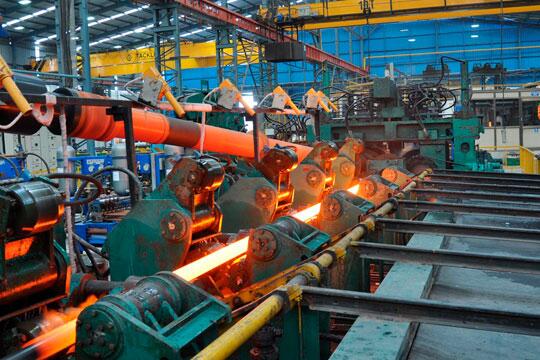
Cross-rolling Piercing Process and Quality Defects and their Prevention
Cross-rolling piercing overcomes the shortcomings of pressure punching and push-rolling piercing, which have small perforation deformation and short and thick capillary. A cross-rolling extension machine is added to the hot-rolled seamless pipe unit to reduce the roll after piercing. It is the most widely used piercing process in the production of seamless pipes to adjust the outer diameter and wall thickness of the capillary, and to make the billet axially elongate along the piercing direction. The cross-rolling piercing machine includes two-roll cross-rolling piercing machine and three-roll cross-rolling piercing machine. The capillary quality defects produced by cross-rolling and piercing of tube blank mainly include inward fold, outward fold, uneven wall thickness and surface scratches of capillary.

Capillary infolding: Capillary is the defect most likely to occur in cross-rolling piercing, and it is closely related to the piercing performance of the tube blank, the adjustment of the piercing process parameters of the piercing pass machine, and the quality of the piercing plug. Factors affecting capillary infolding: one is the reduction (rate) and compression times before the plug; the other is the hole shape; the third is the surface quality of the plug.
Outward bending of the capillary tube: Most of the outward bending of the capillary tube is caused by the surface defect of the tube blank, which is another surface quality defect that is easily caused when the tube blank is cross-rolled and pierced. Factors affecting capillary outward bending: A. tube blank plasticity and perforation deformation; B. tube blank surface defects; C. perforation tool quality and pass shape.
Uneven capillary wall thickness: There are uneven transverse wall thickness and uneven longitudinal wall thickness. When cross-rolling and piercing, uneven transverse wall thickness is most likely to occur. The main factors affecting the uneven transverse wall thickness of the capillary tube are: the heating temperature of the tube blank, the centering of the tube end, the adjustment of the hole pattern of the piercing machine and the shape of the tool, etc.
Capillary surface scratches: Although the requirements for the surface quality of perforated capillary pipes are not as strict as those of pipe rolling mills and sizing mills for steel pipe surface quality, severe surface scratches of capillary pipes will also affect the surface quality of steel pipes. Factors affecting the surface abrasion of the capillary tube: mainly because the surface of the perforating tool or the exit roller table of the piercing machine is severely worn, rough or the roller table does not rotate. In order to prevent the capillary surface from being scratched by the surface defects of the perforating tool, the inspection and grinding of the perforating tool (guide cylinder and trough) should be strengthened.
Go here to learn more about " Heating Defects and Preventive Measures of Seamless Steel Tube Billets "


